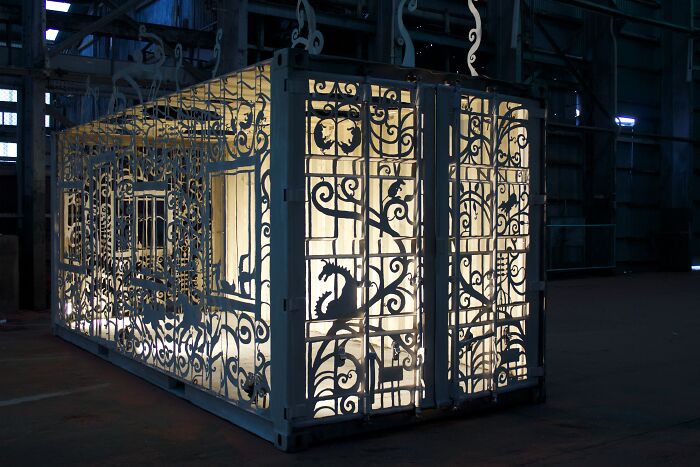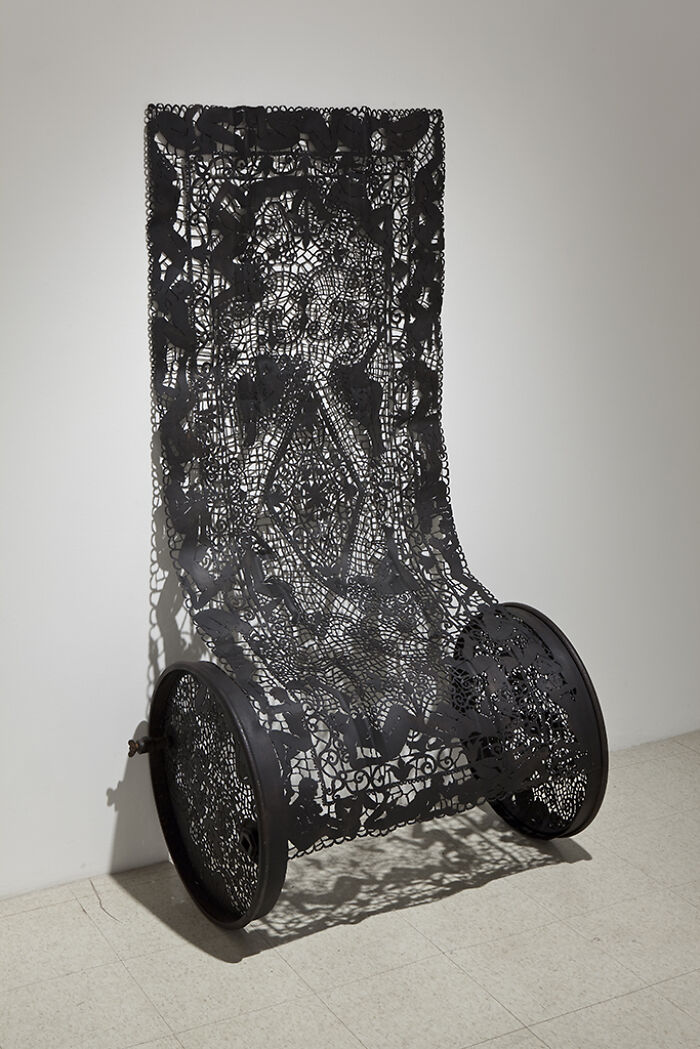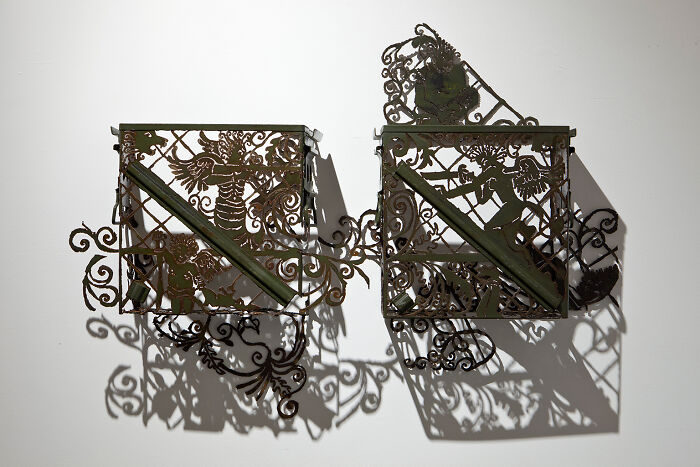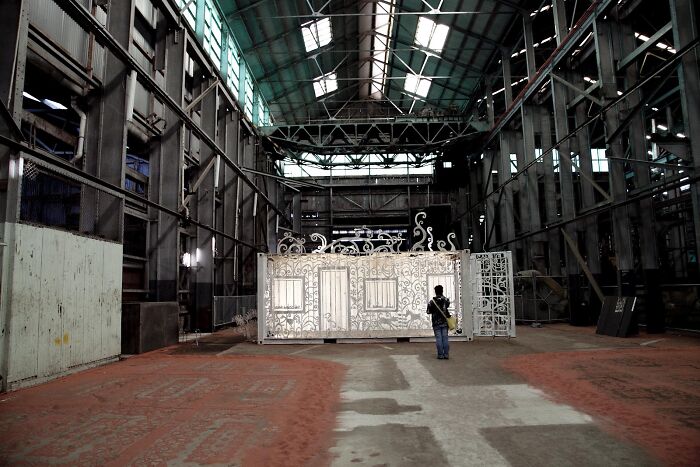
Sculptures Of Paradox: This Artist Combines Delicate Laced Patterns With Heavy Steel Objects (43 Pics)
Interview With ArtistCal Lane is a Canadian artist based in New York. She is known for her outstanding sculptures made of industrial objects, turned into lacy pieces of art. In her early years, back in Vancouver Island, Cal became interested in exploring gender roles and conceptual art. Lane’s sculptures combine elements of two completely opposite qualities creating a coherent whole. The artist uses heavy materials and turns them into the most delicate and light objects.
Steel, very often associated with strong masculinity, thanks to Cal Lane, gets a completely different shape. The artist softens its image by carving lace-like patterns which significantly transform its presentation into something much more feminine. This way we can watch the paradox of these two worlds merging together. Lane uses various materials like car and truck hoods, spades, wheelbarrows, oil drums, and others. When it comes to the patterns Cal chooses for her laces, they very often have references to religion and also hint at lace’s metaphorical capacity to both expose and conceal.
More info: Instagram | Facebook | callane.com

This post may include affiliate links.
Bored Panda reached out to Cal Lane to find out more about her unique work. First, we asked how the artist navigates the tension between the lace patterns and the sturdy, masculine objects they adorn. We found out that: “People often assume because I work with lace and ornament that it is because I am celebrating it, but the seed to working with these delicate images came out of frustration towards how we need to fit into the gender rules that society creates and the meaningless value judgment that comes with it.I grew up in my mother's hair salon in a small town in Canada and it was assumed I would take over the shop, but the idea of fussing with hair, makeup, clothes and my speech made me miserable. I was a tomboy who wanted to do everything I wasn't supposed to do; get dirty, build things, explore, and get into fights.”
Lane continued: “When I was little, I could see that the popular girls were the ones who were pretty, clean, well-behaved in their sweet dresses. I couldn't understand how any kid could avoid having skinned knees which I always had. I realized climbing trees and exploring the world were more important to me than being popular. I switched from my mother's hair salon to going to trade school to become a welder and it felt right. I could dress how I wanted, get away with not styling my hair or wearing makeup, could swear and be the person I craved. Abandoning the rules of femininity saved my life, I finally felt like I could exist in this world. But an interesting thing happened in my years of working as a welder: a new set of rules and conformity existed. I was now expected to be this tough butch woman.”
“I try to approach the world without expectations or judgments; it is the only way to really experience something for what it is. I was uncomfortable with other people's expectations of me. In some ways, I see my life as a social experiment. I can't help pushing against expectations. My work became a visual devil's advocate, placing opposing materials, patterns, images, and techniques together. Making things was always a way for me to make some sense of the world; it puts the world in my head with the world outside my head.
The first lace-like object I created was a series of doilies. They were hand cut with an oxy-acetylene torch out of thick steel. The process of flame-cutting steel is such a pleasure; to be able to melt away something too hard and industrial into a lace object seemed both poignant and funny to me. It became the perfect image to attempt this visual and psychological balance. And an attempt to debunk the expectations in material, gender, image, and object.”
We asked if Cal could share a specific instance or experience where her artwork sparked an interesting conversation or reaction from viewers. Lane shared with us: “Years ago I was asked to create a large-scale sculpture for the courtyard at the Art Gallery of Nova Scotia and be their artist in residence. For part of the residency, I flame-cut large steel doilies out in the public space. The local schools would bring groups of children to watch me work, when I took a break some of the girls came up to me to look closer. When I let one girl wear my welding jacket and pretend to cut steel; they all wanted to do it. That to me was exciting, I could see the girls saw this as a possibility and the boys didn’t think anything strange about that. I still get emails from women who said I was the inspiration for them to learn to weld."
Next, we wanted to know how the creative process unfolds when the artist is working with unconventional materials like car hoods, shovels, and oil drums. Cal Lane told us: “As much as I love to work with steel, I don't want the material to hold me back, it is important to me to keep working in other materials. I like the idea of choosing an idea and then choosing the material that best suits the idea and not the other way around. Having said that, steel is special to me for so many reasons. I have a past with the material, it's not just a material for me - it is a symbol of cold tough masculine industrial, a perfect material to deconstruct. I usually start with an idea and a drawing but I also let the process take over as well. For me, somewhere between logic and intuition is what I love. Too much planning makes a boring piece and too much whimsy makes a shallow piece, but both confronting each other creates a deep yet comical piece. This is the place I want to be.”
Then we were wondering how Lane hopes her artwork challenges or disrupts conventional notions of craft and construction and what kind of dialogue or conversation she is aiming to initiate with her viewers. The artist said: “When I started out studying sculpture, there was a boys' club type attitude there as well. The sculptors we studied were almost all men and the aesthetic was still celebrating a modernist industrial idea. This celebration of the industry and the machine-made didn't make sense to me anymore, the world was changing, (as it does), industry is killing the planet and a particle society isn't quite celebrated like it used to.
My large-scale steel pieces were a connection and a criticism of the past. Large steel i-beams were a common material in sculpture. Large, commanding, tough, masculine, machine-made towering presence that I then hand-cut into 'fancy work' corroded the glamor and awe of the arrogance of our past. Maybe what society considered weak and fragile is really the fabric that holds us together and keeps one strong. I am always working on new work, experimenting with new materials and ideas. I am working on a new show which will be at C24 Gallery next year, a gallery on 24th St in Chelsea, NY.”
Lastly, we asked if Cal could give us a glimpse into her future artistic endeavors. She said: “I am reluctant to talk about my new work because I am still processing and changing things. I am a very solitary artist and find it best to work alone where I can consider things naturally without too many influences. I live in the country but close to Manhattan which provides both the solitary isolation I crave and the incredible inspiration of the city which I also crave.
Sometimes I shave my head, sometimes I grow it long. Sometimes my hair is grey, sometimes green. I crave change and experimentation and everything wondrous and new with respect and acknowledgment to our past, good and bad.”
I was thinking the same thing, thong chasity belt
Load More Replies...
 Dark Mode
Dark Mode 

 No fees, cancel anytime
No fees, cancel anytime 

























































































































